SNL’s Catchphrases
A catchphrase is a word or phrase that is widely recognized because it is repeated so often that its usage is no longer limited to its original source. For a catchphrase to catch on, it needs to generate laughs the first few times it’s said. It then needs to be repeated often enough to the point that the audience is expecting and waiting to hear it—until its expiration date and another popular catchphrase has taken its place.
On situation comedies, a catchphrase becomes a character’s trademark. The audience expects to hear Fred Flintstone shout, “Yabba, dabba, do!”; Friends’ Joey Tribbiani (Matt LeBlanc) to enter a room a room and ask, “How you doin’?”; and for Big Bang Theory’s Sheldon Cooper (Jim Parsons) to top off a joke or prank only he thinks is funny with “Bazinga!” What makes the audience laugh is not only the phrase itself but who says it, the context in which it’s said, and the actor’s delivery.
Stand-up comics use catchphrases for essentially the same purpose. For example, a catchphrase like, “I get no respect. No respect,” defined Rodney Dangerfield in the 1980s. No Respect is the title of his 1981 Grammy-winning comedy album. Two years later, Dangerfield turned it into a rap song and music video, “Rappin’ Rodney.” On October 9, 2004, five days after his death, SNL paid homage to the legendary comedian in a short sketch (30.2) in which Dangerfield (Darrell Hammond) gets to do his stand-up one last time at the Gates of Heaven before St. Peter invites him in. “Finally,” Dangerfield says. “A little respect.”
SNL poked fun at catchphrase comedy not once but twice, in promos for “The Original Kings of Catchphrase Comedy” (36.17) and its sequel, “The Original Kings of Catchphrase Comedy, Volume 2” (37.5), which feature a host of catchphrase comedians like Mike “Insert Joke Here” Henry (Fred Armisen), Goran “Funky Boy” Bogdan (Paul Brittain), Slappy Pappy (Bobby Moynihan), David “Beef Jelly” Winfield (Kenan Thompson), and Bonnie “My Vagina” Carolina (Nasim Pedrad)—all of whom appear to have built a career by running a catchphrase into the ground. Ironically, a parody of catchphrase comedians is airing on a sketch comedy show that is the birthplace of dozens of catchphrases and opens each week with the catchphrase “Live from New York, it’s Saturday Night!”
This very issue was addressed in a hilarious, self-reflexive Robert Smigel cartoon that aired toward the end of SNL’s twenty-fifth season (25.18). In “The Life of a Catch Phrase,” an animated Lorne Michaels responds to complaints he has received from viewers about beating s–t into the ground and hearing the same catchphrases over and over again. Michaels explains that the life of a catchphrase is tenuous—“Even the ones you love today can’t last forever.” To illustrate his point, he screens The Life of a Catch Phrase, which begins with the creation of the catchphrase “Yeah, that’s the ticket” by men in lab coats. It’s implanted into Jon Lovitz’s brain and then repeated over and over on the show, in his bedroom, and on The Tonight Show with Johnny Carson. Lovitz is soon sitting in a throne on top of piles of money. But when Lorne Michaels walks in carrying Dana Carvey, sets him down, and Carvey says the Church Lady’s catchphrase “Isn’t that special?,” Lovitz loses the money and the fame and ends up doing appearances in shopping malls. Cut to 2019, when Lovitz is transported in a flying saucer to a planet inhabited by little green men, who are a whole new generation of fans who laugh hysterically at Lovitz and his catchphrase “That’s the ticket!”
Here are some of Saturday Night Live’s top catchphrases, who said them and why, and the episode in which you heard them first.
Land Shark (Chevy Chase): “Candygram.” (1.4)
One of the many ways the Land Shark tries to get unsuspecting females to answer the door is to pretend he is delivering a Candygram, which is a box of candy delivered to a person’s door with a personal message (1.4). For more on the Land Shark, played by Chevy Chase, see chapter 6.
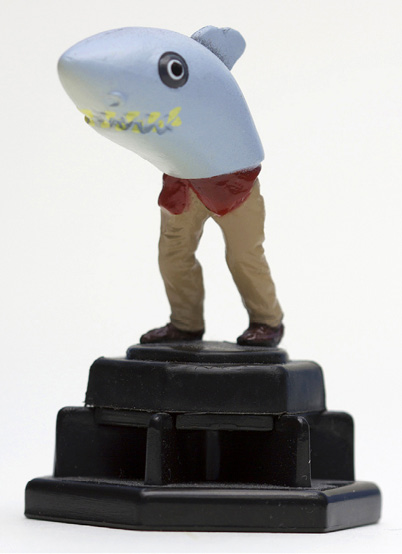
“Candygram!”: The land shark lures innocent women to their door by posing as a delivery man.
Photo by Travis Rainey
Chevy Chase, anchor, Weekend Update: “I’m Chevy Chase and you’re not.” (1.4) and “Generalissimo Francisco Franco is still dead.” (1.7)
“I’m Chevy Chase and you’re not” was Chase’s most popular catchphrase, which he used to open his Weekend Update newscasts. To understand the significance of the catchphrase regarding Franco, you need to understand the context in which it was repeatedly delivered.
After leading the Nationalists to victory in the Spanish Civil War (1936–1939), General Francisco Franco’s fascist regime ruled Spain for thirty-six years. Beginning in October 1975 and continuing through his death from heart failure on November 20, 1975, the media reported on the status of the dictator’s health. He was sick, and then he was feeling better, then his condition worsened, and eventually, on October 30, he fell into a coma.
On November 22, 1975 (1.6), Weekend Update anchor Chevy Chase reported that Franco had died and read an actual quote from President Richard Nixon on his passing, which could have been easily misinterpreted as a joke: “General Franco was a loyal friend and ally of the United States. He earned worldwide respect for Spain through firmness and fairness.” Behind Chase there’s a photo of Franco standing next to Hitler and giving the fascist salute. Chase added that despite his death and burial tomorrow, “the doctors say the dictator’s health has taken a turn for the worse.”
In a comedic exercise in how long can you milk a joke and continue to generate laughs, Chase continued to report on Franco’s health, despite the fact that he was pushing up daisies. On next week’s show (1.7), the top story was “Generalissimo Francisco Franco is still dead.” In the weeks that followed, Franco stayed in the news. On January 10, 1976 (1.9), Chase reported that Franco and Chinese premier Zhou Enlai, who died on January 8, had “high level talks” about Spanish rice (1.9). Two weeks later (1.11), Chase reported that Franco was critically dead, but doctors won’t speculate on how long his current condition could last. Over the following weeks, Franco is the reason why Teddy, a koala bear, committed suicide (1.14); and the focus of a live report (1.17) in which Franco’s secretary (played by White House press secretary Ron Nessen) tells reporter Laraine Newman that Franco is dead but stable. He even scores 10 out of 10 in cadaver diving at the Montreal Olympics (1.24). Finally, on his last telecast (2.6), Chase gets a collect phone call from the generalissimo himself to say goodbye.
Emily Litella: “Never mind.” (1.7)
Litella’s first appearance was as a guest on a talk show, Looks at Books (1.5), in which she discusses her book Tiny Kingdom with host Jane Curtin. Two shows later (1.7), she gives her first editorial reply on Weekend Update on the subject of “busting” (busing) schoolchildren. Once anchor Chevy Chase points out her mistake, she apologizes and says, “Never mind.” Chase is more patient with her than anchor Jane Curtin. For more about Litella, see chapter 6.
Beldar and Prymaat Conehead: “We come from France.” (2.11)
In the first installment of “The Coneheads at Home,” Connie Conehead (Laraine Newman) complains to her parental units, Beldar and Prymaat Conehead (Dan Aykroyd and Jane Curtin), that the kids at school know she is different and keep asking her where she is from. Beldar and Prymaat tell her to give the same standard response they give to earthlings—that they come from France. For more about the Coneheads, see chapters 6 and 23.
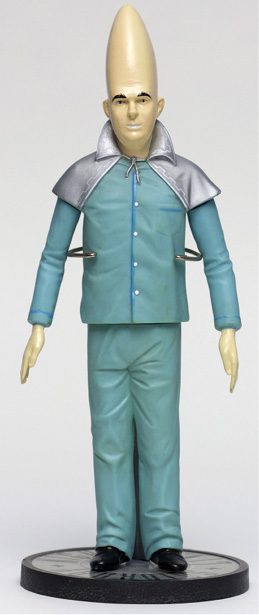
“We come from France” is Beldar Conehead’s standard response when someone asks him where he’s from.
Photo by Travis Rainey
John Belushi: “But nooooooooo!” (2.19)
John Belushi’s favorite catchphrase whenever he would go off on a rant, usually when he was giving a commentary on Weekend Update, was “But noooooooo!” It was incorporated into his explanation on the different kinds of weather to shut-ins and people too paranoid to go outside (2.19). As was always the case, he was soon off the topic and started to talk about India (“You can’t eat the cows because nooooo! They won’t eat the cow!”) and Japanese eating raw fish (“I mean, didn’t they invent the hibachi? But, nooooooo! They won’t do that! . . . They want to eat it raw.”). His later editorials turn into rants about bar fights (3.11), the demolition of Radio City Music Hall (3.16), and the government wasting money on the U.S. space program (4.19). Belushi also delivered one of his more memorable rants when he interrupts host Art Garfunkel’s rendition of “(What a) Wonderful World” (3.13). Garfunkel stops the song when he starts to get feedback from his microphone, prompting Belushi to appear on the stage and start complaining about the inferior equipment the network forces them to use because they are a late-night show. When Garfunkel sheepishly tells Belushi that the sound is okay and maybe he was a little off-key (Art Garfunkel off-key?), Belushi accuses “Mr. LP” of turning on him “like a shark!”
In Pisano and Colby’s biography Belushi, writer Alan Zweibel recalled watching Belushi doing his weatherman character on the monitor with Lorne Michaels, who compared the comedian with Jackie Gleason. “And he was right,” Zweibel agrees. “When you think about it there was a lot of Jackie Gleason, a lot of Ralph Kramden.” Zweibel also observed how, unlike most Jewish and ethnic entertainers that came before him, John never assimilated. “He didn’t blend in. He did it on his own terms,” Zweibel added. “He was the angry, rebellious voice they all identified with. It’s a little wonder a nation of immigrants embraced him.”
Georg and Yortuk Festrunk: “We’re two wild and crazy guys.” (3.1)
Georg and Yortuk Festrunk (Steve Martin and Dan Aykroyd), two brothers from Czechoslovakia, are wannabe playboys who want to “swing” with a pair of American “foxes.” They are totally clueless that the way they dress and behave and the catchphrases they use (like “You and what army?”) are neither hip nor a turn-on to women. But they still consider themselves to be “wild and crazy guys,” an expression that comes from a catchphrase Steve Martin popularized in the 1970s in his comedy routine. For more about the Festrunk Brothers, see chapter 6.
Roseanne Roseannadanna: “It just goes to show you, it’s always something.” (3.9)
Although she first appeared in a sketch entitled “Hire the Incompetent” (3.4), Roseanne Roseannadanna began using her catchphrase until she joined the Weekend Update team as a correspondent. When responding to a letter from Mr. Richard Feder from Fort Lee, New Jersey, Roseannadanna had a tendency to go off on a tangent and start describing something irrelevant and unpleasant (like a “teeny tiny ball o’ sweat” hanging off Dr. Joyce Brothers’s nose [4.6]). When anchorwoman Jane Curtin couldn’t bear it anymore and told her to stop, Roseanne would tell her, “Well, Jane. It just goes to show you. It’s always something.” (For more on Roseanne Roseannadanna, see chapter 6.)
Pete Dionasopolis, Olympia Café Owner: “Cheezburger, cheezburger, cheezburger.” (3.10)
This is what you hear Pete Dionasopolis (John Belushi) and his staff shouting back and forth to each other behind the counter of the Olympia Café when an order comes in, because “cheezburgers” are the only thing on their menu (along with chips and Pepsi) (3.10). For more about Pete and the Olympia Café, see chapter 6.
Dan Aykroyd, Weekend Update Anchor: “Jane, you ignorant slut.” (4.3)
In 1971, 60 Minutes added a segment entitled “Point/Counterpoint,” in which conservative editorial columnist and former segregationist James J. Kilpatrick and a liberal commentator faced off in a three-minute debate on a current issue. In his historical study of 60 Minutes, David Blum recounts how the first liberal commentator, Nicholas von Hoffman, who wrote for the Washington Post, was fired in 1974 by 60 Minutes producer Don Hewitt for calling President Nixon “a dead mouse on the kitchen floor that everyone was afraid to touch and throw in the garbage.”
In 1975, von Hoffman was replaced by Shana Alexander, who was the first female staff writer and columnist for Life magazine. Kilpatrick and Alexander were satirized on Weekend Update by anchor Jane Curtin and Weekend Update station manager Dan Aykroyd. In the first installment, a debate over “test tube babies,” Curtin takes the liberal position and Aykroyd the conservative. She calls him a “cold pompous ass” for denying a woman the opportunity to conceive a child. He begins his short rant with “Jane, you ignorant slut.”
In future broadcasts they debated the Shah of Iran (4.5), U.S.–China diplomatic relations (4.9), the rise of cocaine use/drug laws (4.12), palimony (4.15), and nuclear power (“Jane, you magnificently ignorant slut”). Aykroyd always started with the same line, to which Curtin has no reaction at all. For the record, Curtin managed to get some good potshots in also, calling Dan a “reactionary ass,” “self-important swine ass,” and a “miserable failure.” But Aykroyd calling Curtin an “ignorant slut” is what America wanted and waited to hear.
Paulie Herman: “Are you from Jersey?” (6.3)
The annoying, clueless guy from Jersey who coined the catchphrase “Are you from Jersey? I’m from Jersey” tries video dating (6.3); is hustled in a game of three-card monte by Eddie Murphy (6.4); visits the Turnpike Diner, where he charms a customer (Karen Black, who recreates the scene in which she appeared in Five Easy Pieces [1970] in which Jack Nicholson orders wheat toast) (6.10); and falls for another Jerseyite (Deborah Harry) on Valentine’s Day (6.10). In the next season, Paulie returned (7.9) alongside pimp Velvet Jones (Eddie Murphy) to announce that both of their characters won’t be seen again as they’ve died—from overexposure.
The highlight of the Paulie Herman sketches was a parody of an industrial film entitled “Formula for the Good Life” in which we see Paulie Herman in his natural habitat—working at the United Chemical Company plant in Piscataway, New Jersey. He takes the audience on a tour of the plant and doesn’t seem to mind that everything is covered with white powder, which, at one point, falls into the sandwich he’s eating. Afterwards, he visits one of New Jersey’s landmarks, the Paramus Mall. Apparently, the mayor of Piscataway, Robert G. Smith, was not amused by the depiction of his city as the toxic chemical waste dump capital of the nation. According to a March 1981 UPI story, NBC regretted that he was offended, but they “did not believe a public apology is appropriate.”
Buckwheat: “O-tay!” (7.2)
In the 1980s, Eddie Murphy resurrected Buckwheat, one of the Little Rascals, whose command of the English language was severely limited and coupled with a speech impediment. “O-tay” was his way of saying, “Okay.” Murphy’s Buckwheat, who is now all grown up, can’t even pronounce his own name. It sounds more like “Buh-Weet,” which is how it is spelled on the cover of his album, Buh-Weet Sings (7.1). For more about Buckwheat, see chapter 8.
Gumby: “I’m Gumby, damnit!” (7.15)
Gumby is a green claymation figure created by Art Clokey that made his television debut in the 1950s on The Howdy Doody Show (1947–1960) before getting his own television series, which aired from 1957 to 1968. With his best friend, a red pony named Pokey, Gumby was a kind and considerate fellow who was always willing to help others.
As he had done with Buckwheat, Eddie Murphy resurrected Gumby for 1980s television audiences who grew up watching the little green guy on television. But Gumby is no longer a sweet, kindhearted, heroic kid but a cantankerous, old, cigar-smoking Jewish entertainer who is very bitter about the way the industry treats cartoon characters. He writes two exposés on the industry: I’m Gumby, Damnit, which he plugs on The Uncle Tom Show, a children’s show hosted by Tom Snyder (Joe Piscopo) (7.15); and I Am Show Business, Damnit, which he promotes on Late Night with David Letterman (1982–1993) (8.1) along with dishing some dirt on the Keebler Elves and Poppin’ Fresh. Gumby resurfaces again to reunite with Pokey (Joe Piscopo), who complains of chest pains to a less-than-sympathetic Gumby, who tells him, “You are not working with me, you are working for me.” Gumby also writes and directs The Gumby Story (9.4), only to have a movie executive close down the production. When Murphy returned to SNL as host (10.9), Gumby appears in a parody of Woody Allen’s Broadway Danny Rose (1984) in which he has lunch at Fishman’s Deli with other aging Jewish comedians.
In a 1985 People magazine article, Jack Friedman reported on the renaissance of Gumby, who had a whole new generation of fans thanks to videocassettes and reruns in the major television markets. Gumby returned in a new show, Gumby Adventures (1988–2002), and a feature-length film, Gumby: The Movie, was released in 1995. Sixty-three-year-old Clokey did not attribute Gumby’s newfound popularity to Eddie Murphy, but to a swami who sprinkled “generated sacred ash” over a Gumby action figure. “Ever since then,” Clokey admits, “Gumby has been doing amazing things.”
Fernando: “You look mahvelous!”
Billy Crystal based the character “Fernando” on Fernando Lamas (1915–1982), a handsome Argentine actor and singer who played romantic leads and Latin lover roles in MGM films in the 1950s, starring opposite Lana Turner (The Merry Widow [1952]), Elizabeth Taylor (The Girl Who Had Everything [1953]), and his fourth wife, Esther Williams (Dangerous When Wet [1953]). In a 1985 interview for Playboy, Crystal recalled watching Lamas when he would appear as Carson’s guest on The Tonight Show: “He used to have him on there, because he would say, ‘You look marvelous, John. That was really marvelous’—but not the way I do it. He would just say it, and that seemed to be the thrust of his in-depth conversation.” During one appearance, Carson told Lamas that he looked great too. Fernando replied, “I’d rather look good than feel good.” Crystal found this line to be hysterically funny and wrote it down.
Crystal also made it very clear in the interview that he was not doing Fernando Lamas. “The late Mr. Lamas [who died in 1982] was a nice, intelligent man,” Crystal added. “My guy is an idiot. But he means well.” When Fernando first appeared on SNL (and was introduced as Fernando Lamas), he sat behind the Saturday Night News desk and offered his assessment of who looks mahvelous among the presidential candidates and Oscar contenders. The audience wasn’t sure what to make of him (and some were no doubt wondering, “Who is Fernando Lamas?”). He was back again toward the end of the season (9.19), upset that retired NBC newscaster Edwin Newman is the one anchoring the news instead of him (but assures Newman that he looks mahvelous). When Crystal joined the cast the following season (1984–1985), he was eventually given his own recurring sketch, Fernando’s Hideaway, where he’s visited by Ringo Starr and his wife, Barbara Bach (10.8); Mr. T and Hulk Hogan (10.15); and Howard Cosell (10.17). Fernando’s last SNL appearance was on the SNL 25th Anniversary Special, in which he marvels over the celebrities in the audience, mistaking Steve Martin for Phil Donahue and Chris Rock for Eddie Murphy.
Crystal’s impression of Lamas was not the first on SNL. He was imitated by Bill Murray in season 2 in a sketch (2.21) in which he, Ricardo Montalban (Aykroyd), and Cesar Romero (Belushi) approach women in a restaurant and ask the women to tell them apart because they have been best friends who do everything together for so long and they can no longer tell themselves apart.
Tommy Flanagan: “That’s the ticket!” (11.2)
The idiom, which means “Yes, that’s it! That’s right!,” dates back to the nineteenth century, though its exact origins are the subject of debate. Some believe it was derived from the French phrase c’est l’etiquette, which translates as “that’s the proper thing or course of action” with the word “etiquette” having been twisted into the word “ticket.” Some believe it’s more likely that “ticket” refers to “political ticket” (as in “that’s the right party or candidate”).
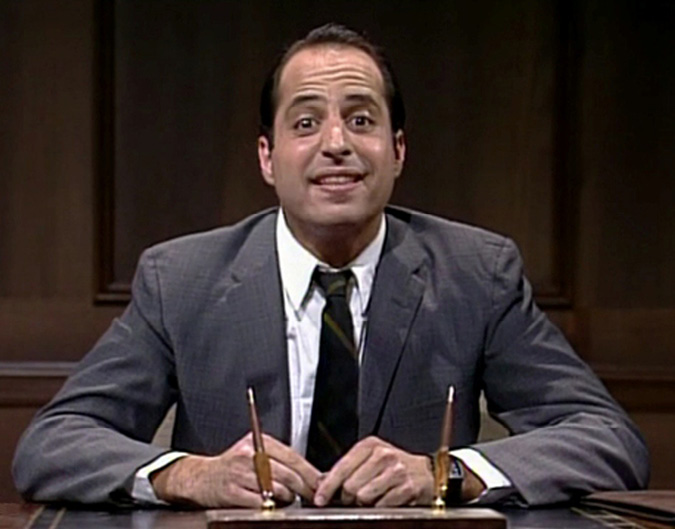
“That’s the ticket” is a favorite catchphrase of pathological liar Tommy Flanagan (Jon Lovitz).
The phrase was popularized on SNL by pathological liar Tommy Flanagan, played by Jon Lovitz. Prior to joining the cast of SNL in the fall of 1985, the comedian appeared as Flanagan on The Tonight Show Starring Johnny Carson (1962–1992), introducing himself as the President of Pathological Liars Anonymous. Lovitz did a variation of the same routine when he first appeared as Flanagan on SNL in a PSA on behalf of the same group, and claimed to have joined the army at the age of thirteen and served in Vietnam, where he caught a mortar shell in his teeth and was made a three-star general. He also said that he killed himself over the death of his cousin, boxer Joe Louis, and was medically dead for a week until he was brought back to life by Indian prime minister Indira Gandhi. One more lie that he liked to tell—he’s married to Morgan Fairchild. Between 1985 and 1989, Flanagan pops up over a dozen times, hitting on guest host Jerry Hall (11.10) and appearing in Rosanna Arquette’s dressing room (12.3) and in the middle of Oprah Winfrey’s monologue (11.14). He’s even the self-appointed official spokesman for NBC who responds to SNL’s decline in the ratings by telling everyone the ratings are “through the roof! . . . Neck and neck with The Cosby Show!”
The Church Lady: “Well, isn’t that special?”
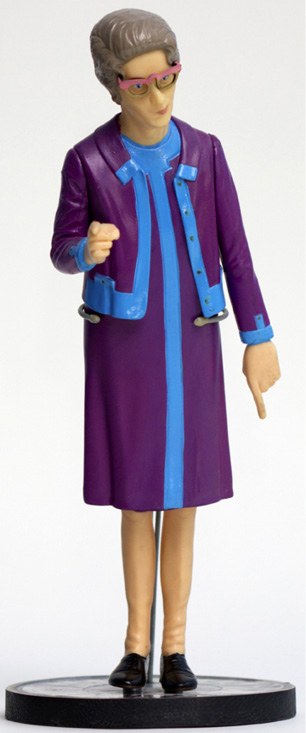
“Isn’t that special?” asks the Church Lady.
Photo by Travis Rainey
A rhetorical question used by Enid Strict, a.k.a. the Church Lady, whenever she hears something that is objectionable. To read more about the Church Lady, see chapter 9.
Hans (Dana Carvey) and Franz (Kevin Nealon), hosts of Pumping Up with Hans & Franz: “We are here to pump [clap] you up!” (13.1)
This was a promise made by Hans and Franz, a pair of Austrian bodybuilders and cousins of Arnold Schwarzenegger, on their television show, Pumping Up with Hans and Franz. But they never kept their word because they spent most of the show flexing their muscles for their viewers when they weren’t insulting them and calling them “girlie men.” Read more about Hans and Franz in chapter 9.
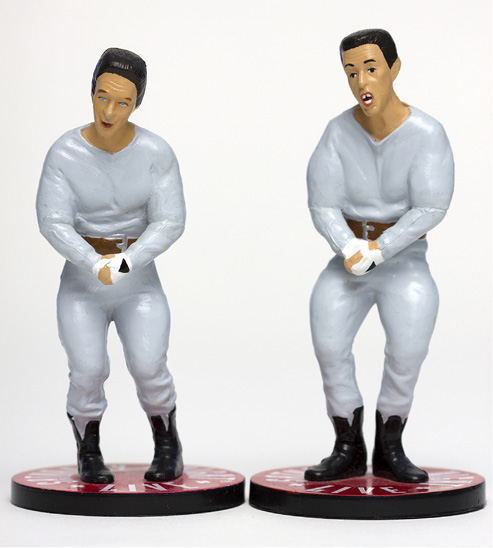
“We’re going to pump you up!” is a promise bodybuilders Hans and Franz make to their viewers.
Photo by Travis Rainey
Wayne’s World’s Wayne Campbell (Mike Myers) and Garth Algar (Dana Carvey): “Excellent,” “. . . Not!,” “Party on!,” “Schhhhhhhwinnnng,” “We’re not worthy,” “Way. (No way.) Way.” (14.13)
Wayne and Garth, hosts of the local access television show Wayne’s World, are the undisputed kings of the SNL catchphrases. Here is how urbandictionary.com defines the words and phrases used and popularized by Wayne and Garth, who in some instances, are also identified as the source. To read more about Wayne’s World, see chapters 9 and 23.
Babe: An attractive young woman.
Babelicious: Babe + Delicious, often applied to supermodels and certain actresses and singers.
. . . Not!: Attributed to Wayne’s World, the addition of “not” at the end of the sentence is a way to make sarcasm more blatant.
Party on!: An exclamation to express that you are excited about something (“Party on, Wayne!” “Party on, Garth!”)
Schwing!: An exclamation used when a guy sees a babe and gets an erection. Urbandictionary.com defines the term as “when Garth or Wayne (Wayne’s World) pop a boner.”
Way!: The proper way to respond to someone when they say, “No way.” When Aerosmith’s Joe Perry tells Wayne they don’t do drugs and alcohol any more, Wayne says, “No way!” Perry replies, “Way!” (15.13)
We’re not worthy!: Exclamation used when one meets someone who is highly distinguished! When Garth sees on the “nook cam” that Aerosmith is upstairs in Wayne’s kitchen, he says, “I’m not worthy! I’m not worthy!” (15.13)
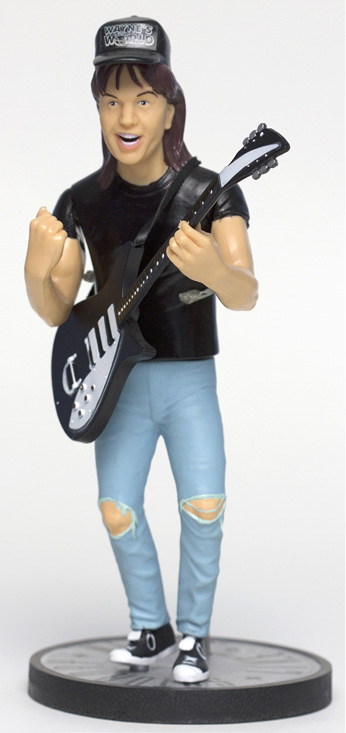
“Party on! Schwing! We’re not worthy!”: One of the kings of SNL catchphrases, Wayne Campbell.
Photo by Travis Rainey
Dieter: “Vould you like to touch my monkey?” “Touch him! Touch my monkey!” (14.16)
Dieter, the pretentious host of a German talk show, Sprockets, usually asks his guests, who are equally bizarre and avant-garde, if they would like to “touch his monkey.” It sounds like a sexual innuendo—except there is an actual live monkey sitting next to him on the top of a column. Dieter has several other expressions he likes to use while interviewing a guest. When he gets excited, he pulls the front of his black turtleneck out as if he has small breasts and says, “Now I am as happy as a little girl.” If he gets bored, he tells the guest, “Your story has become tiresome.” He closes the show by declaring, “Now is the time on Sprockets when we dance.” And they do.
Bill Swerski’s Super Fans: “Da Bears!” (16.10)
It’s the mantra of the men who appear on Bill Swerski’s Super Fans, a television show broadcast from Ditka’s restaurant in Chicago. Smigel told Doug Elfman of the Chicago Sun-Times that the sketch was first performed on stage in Chicago as part of revue entitled The Happy Happy Good Show (the cast included another SNL writer, Conan O’Brien). “That was the first place where I ever tried the Chicago Superfans sketch—the ‘Da Bears’ thing. They would just have conversations about anything. . . . In the script, I didn’t even write ‘Da.’ That was something that was invented in Chicago.” (See also chapter 10.)
Rich Laymer: “Makin’ copies.” (16.11)
Rich Laymer, a.k.a the Richmeister (Rob Schneider), is that guy in your office whose desk is closest to the photocopier. Every time you go to use it, you say hello and he responds by calling you playful variations of your first name followed by “Makin’ copies.” Schneider admitted in a Chicago Tribune story that he did the same thing to Adam Sandler when he would walk by his desk at SNL to go to the water cooler (“Adam, Adam-meister. Going to get some water.”).
Stuart Smalley: “I’m good enough, I’m smart enough, and doggone it, people like me!” (16.12)
This is the mantra of Stuart Smalley (Al Franken), “a caring nurturer, a member of several 12-step programs, but not a licensed therapist,” who hosts Daily Affirmation with Stuart Smalley. It’s also the title of a book of daily affirmations penned by Franken, who wrote and stars in the 1995 feature film Stuart Saves His Family (1995). (Read more about Stuart in chapter 23.)
Linda Richman: “I’m a little verklempt.”
Linda Richman, host of Coffee Talk, would sometimes get a little verklempt, a Yiddish word for excited. It was one of the many Yiddish words and expressions Richman used, some of which were real and others there was no way to be sure. (Read more about Linda Richman in chapter 10.)
Matt Foley, Motivational Speaker (Chris Farley): “[L]iving in a van down by the river!” (18.19)
A popular character on SNL in the early 1990s, Matt Foley was developed on the Second City stage in Chicago by Chris Farley and writer Bob Odenkirk. Overbearing and hyperactive, Foley had a big, loud, presence whose strategy for motivating people was to mock them and tell them to shut up when they tried to get a word in. He also wallowed in his own self-pity, which was meant to serve as a warning that if they don’t wise up, they might end up like him—“35 years old, eating a steady diet of government cheese, thrice divorced, and living in a van down by the river!” Some of his other favorite expressions were “Well, la-dee-frickin-da!” and “Whoop-dee-frickin-do!” Read more about Matt Foley in chapter 10.
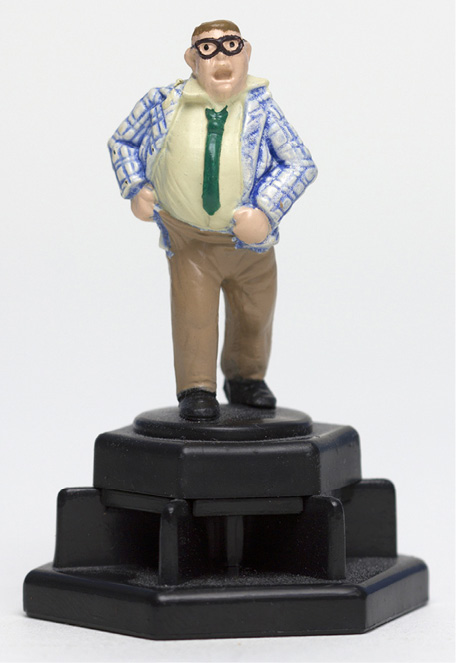
“. . . living in a van down by the river!”: Motivational speaker Matt Foley doesn’t like to soft-pedal his message.
Photo by Travis Rainey
Flight Attendants, Total Bastard Airlines: “Buh-bye.” (19.16)
If you saw these two sketches, it’s hard not to get off an airplane these days and think of this catchphrase, repeated over and over by the flight attendants on Total Bastard Airlines. As passengers get ready to deplane, a voice on the intercom thanks them for “flying the blue skies of Total Bastard” and explains that “we at Total Bastard Airlines are bitter about the career paths we have taken, and we do tend to take that out on our passengers.” Any questions the passengers may have get answered with repeated “Buh-byes,” along with the occasional rude comment or insult. David Spade, who specialized in playing snide characters, is the steward, along with guest host Helen Hunt in the first sketch (19.16) and Ellen Cleghorne in the second (20.1).
In March 1995, Chris Smith did a very critical behind-the-scenes story for New York magazine on SNL entitled “Comedy Isn’t Funny” with the subheading “Saturday Night Live at Twenty—How the Show That Transformed TV Became a Grim Joke.” The story does indeed paint a rather grim picture of the creative dissatisfaction among some of the cast and writers on a show that Michaels himself admits is “fighting for its life.” Smith claims the inclusion of the second Total Bastard Airlines sketch in a “prime spot” on the twentieth-season opener was a way for Michaels to reward David Spade for the work he had done that summer on the film Tommy Boy (1995), which costarred Chris Farley and was produced by Michaels. Smith wrote that the second sketch was “SNL’s biggest blunder this season” (Really? The biggest blunder of season 20?) because it gave critics a chance to “bludgeon SNL” and accuse them of “trying to flog another marketable catchphrase.” Michaels reportedly thought the sketch was funny and was planning to do another until he read that it was judged by some viewers on the Internet the “most hated” sketch in memory.
Bruce Dickinson (Christopher Walken): “More cowbell!” (25.16)
On April 8, 2000, SNL did a parody of VH1: Behind the Music that focused on Blue Öyster Cult, the band best known for songs such as “Burnin’ for You” and “Dancing in the Ruins.” The parody includes footage supposedly shot during a 1976 recording session of the song “(Don’t Fear) The Reaper” supervised by “famed producer” Bruce Dickinson (Christopher Walken) (there was a music producer named Bruce Dickinson, but he was not involved with BÖC until many years later). The SNL regulars impersonate members of the band, though the sketch is not historically accurate in regard to the band members who were around at the time of the recording. In the sketch, Eric Bloom (Chris Parnell) sings the lead vocals, yet Donald “Buck Dharma” Roeser (Chris Kattan) actually sang lead vocals on the song. The other band members—bass guitarist Danny Miranda (Horatio Sanz) and drummer Bobby Rondinelli (Jimmy Fallon)—were not BÖC members until the 1990s. The fifth band member, Gene Frenkle (Will Ferrell), the overly enthusiastic cowbell player, is a figment of Ferrell’s fertile imagination (he wrote the sketch).
Initially, Gene’s cowbell proves to be a distraction to the rest of the band, which creates tension, especially between him and Bloom. But Dickinson or (as he refers to himself “The Bruce Dickinson”) insists on more cowbell: “I got a fever and the only prescription is more cowbell.” He tells Frenkle to “really explore the studio space,” which he does—jumping around all over the studio while hitting the bell.
The whole thing is absurd and completely unexpected. Walken is serious, intense, and, as always, a bit bizarre as he lectures the band about the importance of the cowbell.
Fallon, who developed a reputation for cracking up on camera, told Eric Spitznagel in an interview with Playboy magazine that it really started with the cowbell sketch and Will Ferrell trying to make him laugh: “I was just about to do my line when I looked over at Will—his gut was hanging out of his shirt, his glasses were flying off, he was sweating, and his eyes were nuts, and I just lost it.”
It’s difficult to know why this sketch and the catchphrase it introduced—“More cowbell”—caught on. When E! Entertainment did a countdown of the 101 Most Unforgettable SNL Moments in 2004, “More cowbell” came in at number five. In 2012, Walken told film critic Peter Travers at abcnews.com, “It follows me around.” He also thought enough was enough when he did a play in New York and people would clang cowbells during his curtain calls.
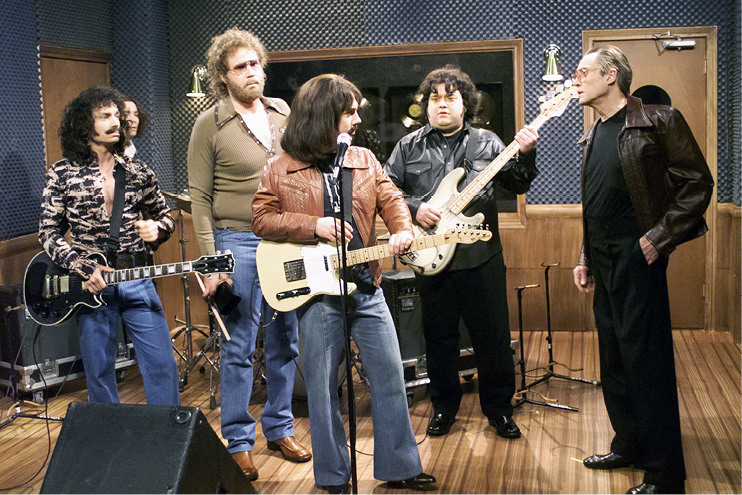
“More cowbell!” insists music producer Christopher Walken (far right) to members of Blue Öyster Cult (left to right) Chris Kattan, Will Ferrell, Chris Parnell, and Horatio Sanz (25.16).
NBCU Photo Bank via Getty Images
Roeser, BÖC’s lead guitarist and cofounder, loved the sketch. “We all thought it was phenomenal,” he told the Washington Post’s Paul Farhi in 2005. “We’re huge Christopher Walken fans. I’ve probably seen it 20 times and I’m still not tired of it.”
Roeser also set the record straight that there was no Gene Frenkle, whose image appears at the end of the sketch along with the words “In Memoriam. 1950–2000.”
So was there actually a cowbell on BÖC’s recording of “Reaper”? According to bassist Joe Bouchard, the cowbell was “overdubbed” (meaning “added”) to the final track. In a 2000 interview with Mark Voger of the Asbury Park Press, Bouchard explained that the producer told Bouchard’s brother, drummer Albert, to put tape around a cowbell and go in the recording studio and play it. Joe Bouchard said you can’t hear it on the original album, but if you listen carefully to the remastered CD, you can hear a cowbell in the background.